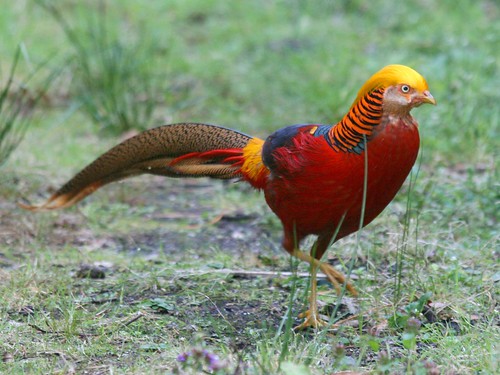Artie does his job exactly as he's bred to do, runs deep into the weeds and flushes the birds out. I on the other hand frequently don't get my part of the job done, and miss the birds.. Once in a while I do hit, thereby avoiding Artie's ire - you should see The Look he gives me after missing - and he faithfully brings it in.
Pheasants are extravagantly beautiful. They are, as Gierach observed of trout, far prettier than they need to be. On the other hand, for the last couple of centuries it's been a very successful strategy from an evolutionary standpoint: be attractive/useful to man, and he'll spread you far and wee across the world. Both pheasants and trout seem like elementals of air and water, jewels that swim and fly. Then men like me come along to turn them into meat.
In the evening, the birds come in from the cornfields to their evening quarters in the bottomlands. We hide behind the haystack and wait to see who shows up. The trick to recognizing a rooster is the C's - either hear him cluck, or see the colour on his face. In the evening the colour trigger isn't usually visible; luckily they'll sometimes declare themselves by chattering to their harem. This evening, four hens swooped in silently. The solitary rooster dropped into the dense weeds. We went to root him out with the dogs but in the meantime he'd run down into the jungles of the wetlands. Outfoxed by a bird, yet again.
Back at the barn having tea, Artie fell asleep standing up, while I scratched his ears. A thoroughly-well-hunted dog.
Update: 'the last couple of centuries', forsooth. Pheasant arrived in England with Caesar's armies. They'd been moving out of Asia for a few thousand years before that. There are some 30 distinct sub-species of the common pheasant; the status in the wild of all of these is unknown. The common and ringneck pheasant are of course not endangered, being so widespread.
Harold Macmillan on pheasants in England, reported in a letter of Patrick Leigh Fermor's,
"We're very lucky to have them. It's entirely due to the Roman occupation of Britain. The junior officers were very fond of them, and collected them in large numbers. I believe there was a certain amount of rivalry about which centurion had the most or the handsomest birds. In the end, of course, in 410 AD, in the reign of the Emperor Honorious, the order came for all the legions to return to Rome, but they weren't allowed to take their birds with them, so very reluctantly, all the centurions let their birds go. There must have been thousands of them. Anyway, they survived the Picts and the Scots, and the Saxon invasion."
There are some other remarkable pheasants. Bird books usually give a picture plus a paragraph or more detailing the 'field signs', the notable features by which the bird may be recognized while twitching. For the Lady Amherst and the Golden pheasant, one word: 'unmistakeable'.
The Lady bird:
From excelglen's flickr set.
The Golden:







No comments:
Post a Comment